Washington is commonly known as the Evergreen State due to its abundant evergreen forests. Not only does the state of Washington have gorgeous forests, but it also has beautiful coastlines and an abundant variety of wildlife to behold. Washington is the place to go for anyone wanting an outdoor adventure!

Washington is known as the Evergreen State due to its abundant evergreen forests.
©iStock.com/septemberlegs
One way to explore the wilderness in the state is to check out the largest forest in the state. The largest forest in Washington State has plenty to do and plenty to see, so let’s discover this wonderful piece of nature together!
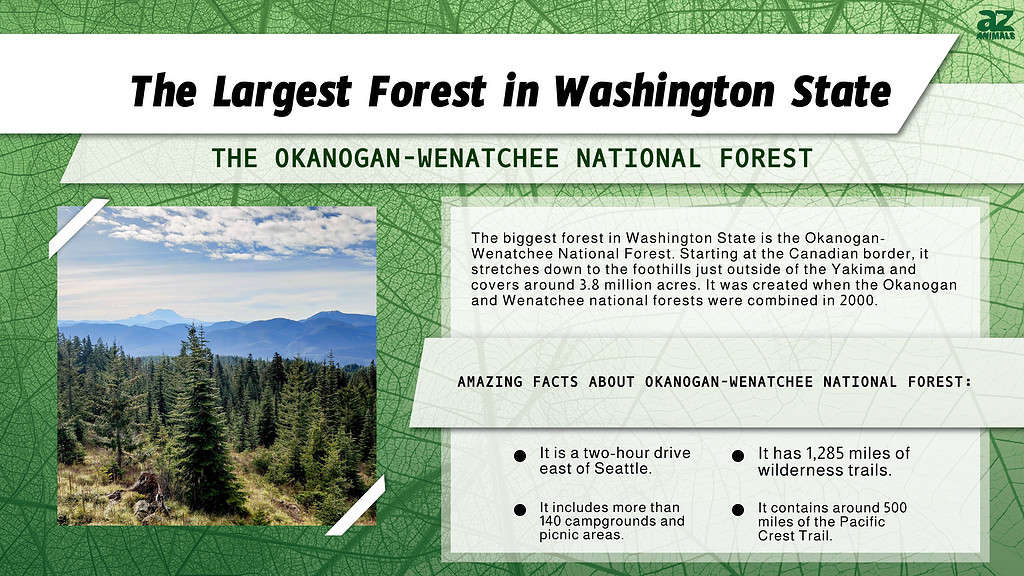
The Largest Forest in Washington State: Okanogan-Wenatchee National Forest
The Okanogan National Forest and the Wenatchee National Forest combined to create the Okanogan-Wenatchee National Forest in 2000. The Okanogan-Wenatchee National Forest is the largest forest in Washington State and spans around 3.8 million acres.
Starting at the Canadian border, it stretches all the way down to the foothills just outside of the Yakima. As it covers such a large area, there are many different settings to explore, including high mountain peaks, deep valleys, vast forests, and two major rivers. The forest is a very popular destination for tourists, offering a range of outdoor activities including hiking, fishing, camping, hunting, and winter activities such as skiing and snowmobiling.
The Okanogan-Wenatchee National Forest has two rivers flowing through it: the Okanogan River and the Wenatchee River.

The Okanogan-Wenatchee National Forest covers approximately 3.8 million acres.
©marcsanchez/Shutterstock.com
Hiking in the Okanogan-Wenatchee National Forest
Hiking in the Okanogan-Wenatchee National Forest is an absolute must. There are 8 miles of barrier-free trails and 1,285 miles of wilderness trails! With the scenery and a mass of wildlife to discover, you will surely enjoy the hiking experience offered in this forest.
Here are some of the most popular hiking trails in the Okanogan-Wenatchee National Forest:
The Pacific Crest Trail
This long-distance trail runs from Mexico to Canada, passing through the Okanogan-Wenatchee Forest along the way. This trail offers amazing views of the forest’s mountain peaks and valleys. The entire trail from start to finish is 2,653 miles long with around 500 of those traversing through this forest.

Around 500 miles of the Pacific Crest Trail traverse through the Okanogan-Wenatchee National Forest.
©Dan Lewis/Shutterstock.com
The Enchantment Lakes Trail
The Enchantment Lakes is a popular destination in the Alpine Lakes Wilderness, which makes up a part of the Okanogan-Wenatchee forest. With an elevation of around 4,500 feet, hikers can expect to see stunning scenery and views of pristine mountain lakes. This trail is 18 miles point-to-point and features 700 picturesque alpine lakes.
The Lake Stuart Trail
On the Lake Stuart Trail, hikers will pass through marshy land and arrive at a stunning lake with views of the surrounding mountain peaks. At 8.7 miles long, this trail isn’t as daunting as others in the forest. However, it is still considered moderately challenging due to the 1,684 feet of elevation gain.
The Icicle Ridge Trail
The Icicle Ridge Trail is a great day hike that offers a fantastic view of the surrounding mountain peaks and valleys. The trail is located near the town of Leavenworth and, at only 6 miles roundtrip, is an excellent option for anyone looking for a shorter hike.
Lake Chelan
The Chelan area of the Okanogan-Wenatchee National Forest contains many different and popular hiking trails to choose from, including the Lakeshore Trail and the Chelan Summit Trail. These trails offer hikers scenic views of Lake Chelan and the surrounding mountains.
Where Is the Okanogan-Wenatchee National Forest Located on a Map?
Located in Okanogan County in north-central Washington, the Okanogan-Wenatchee National Forest is a 2-hour drive from Seattle, which is to its west. Vancouver in Canada to the northwest is a 2.5-hour drive.
Other Activities in the Okanogan-Wenatchee National Forest
There are also plenty of camping opportunities in the Okanogen-Wenatchee National Forest. While a hike can get you up close and personal with nature and wildlife in the forest, camping can further enhance that experience and help you feel one with nature. A camping experience will ensure you experience the forest to its fullest. With more than 140 campgrounds and picnic areas available, you can have your pick on the location of the campsite and fully immerse yourself in nature.
If hiking and camping aren’t your things, don’t worry. There are plenty of other activities that can keep you entertained for hours! If you prefer water sports, try your hand at swimming or boating in the forest. For those looking for a bit more of a thrill, waterskiing is also available in the Naches Ranger District of the forest.
If you want to explore the Okanogan-Wenatchee National Forest in the winter, there are a lot of winter sports to try your hand at, including sledding, skiing, snowboarding, snowmobiling, and even snowshoeing.
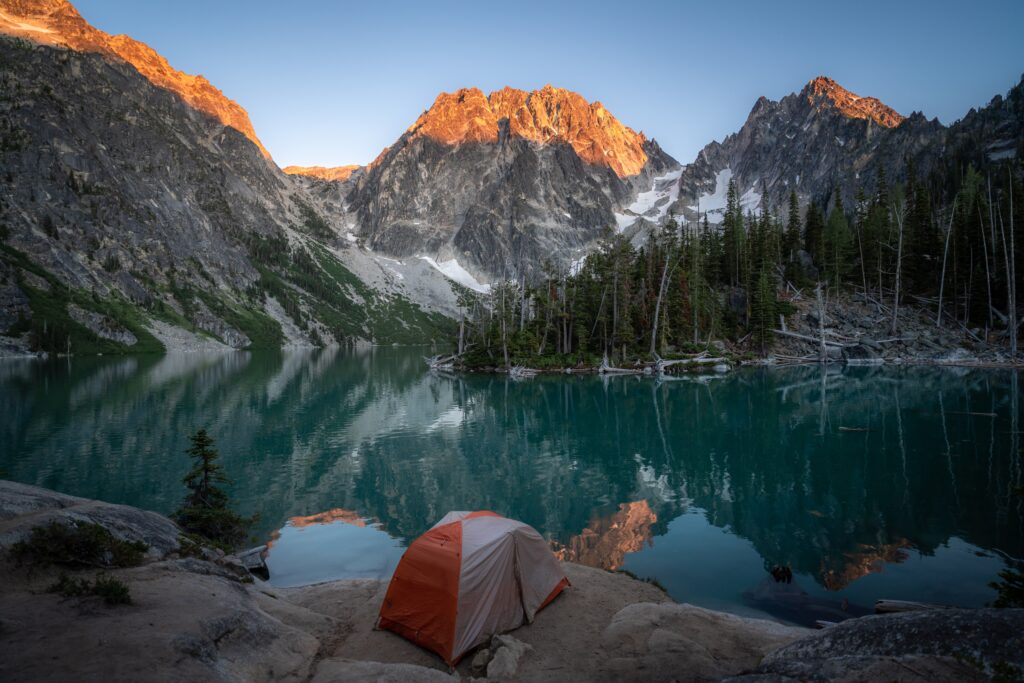
Okanogen-Wenatchee National Forest offers camping opportunities amid stunning scenery.
©Cavan-Images/Shutterstock.com
Wildlife in the Okanogan-Wenatchee National Forest
Due to its enormous size, the Okanogan-Wenatchee National Forest is home to many different animals, fish, and birds. The wide and diverse range of habitats in this Washington State forest means that the animals living here live comfortably and feel right at home. Here, you’ll find plenty of opportunities to discover and observe animals in their natural habitat! Here is just a small sample of the animals you can expect to see in the Okanogan-Wenatchee National Forest:
Lynx
The lynx is a medium-sized wild cat species. There are four types of lynxes around the world, and in the Okanogan-Wenatchee National Forest, you may come across the Canada lynx or the bobcat. The Canada lynx is larger and can weigh from 18 to 31 pounds, while the bobcat is the smallest lynx species, weighing 16 to 30 pounds. The Canada lynx is more likely to be found in forests and tundra, and the bobcat tends to inhabit woodlands, swamps, and mountains.
Lynxes have short tails and tufts of black fur on the tips of their ears. They have a ruff under their neck that looks like a bowtie. Fur color varies from medium brown to almost white with dark brown spots. All lynxes have white fur on their chests, abdomens, and the inner parts of their limbs. Lynxes are predators and create dens under ledges or in crevices. They eat a wide range of animals, including white-tailed deer, reindeer, snowshoe hares, fish, foxes, squirrels, sheep, turkeys, and goats.
Elk
The Okanogan-Wenatchee National Forest is home to a healthy population of elk, the largest members of the deer family. Elk are found throughout North America and are a fairly common sight for visitors to the forest. These elegant creatures can be found in various habitats, including in mountain meadows, forests, and grasslands.
They have a reddish-brown coat and distinctive long hair to help them keep warm in the winter. During mating season, the males can be observed bugling — this is a loud vocalization they use to attract females and is an awesome thing to experience. Elk are an essential part of the Okanogan-Wenatchee National Forest’s ecosystem and are a beloved sight for visitors to the forest.
Mountain Goat
Mountain goats occupy only northwestern North America and can be found from the Canadian border to the Oregon border. In Washington State, there are between 2,400 and 3,200 mountain goats. These goats are quite easy to distinguish from other goats, as they have fully white fur coats, shiny black horns, beards, and short tails. Mountain goats prefer higher elevations, near steep cliffs and slopes above the tree line.
These creatures were built for climbing and are able to climb steep, rocky slopes due to their useful hooves. Mountain goats are herbivores and like to spend a lot of time grazing. Their diet includes grasses, herbs, ferns, lichens, twigs, and leaves. Make sure you check out the cliffs and mountains to catch a glimpse of these fearless animals!
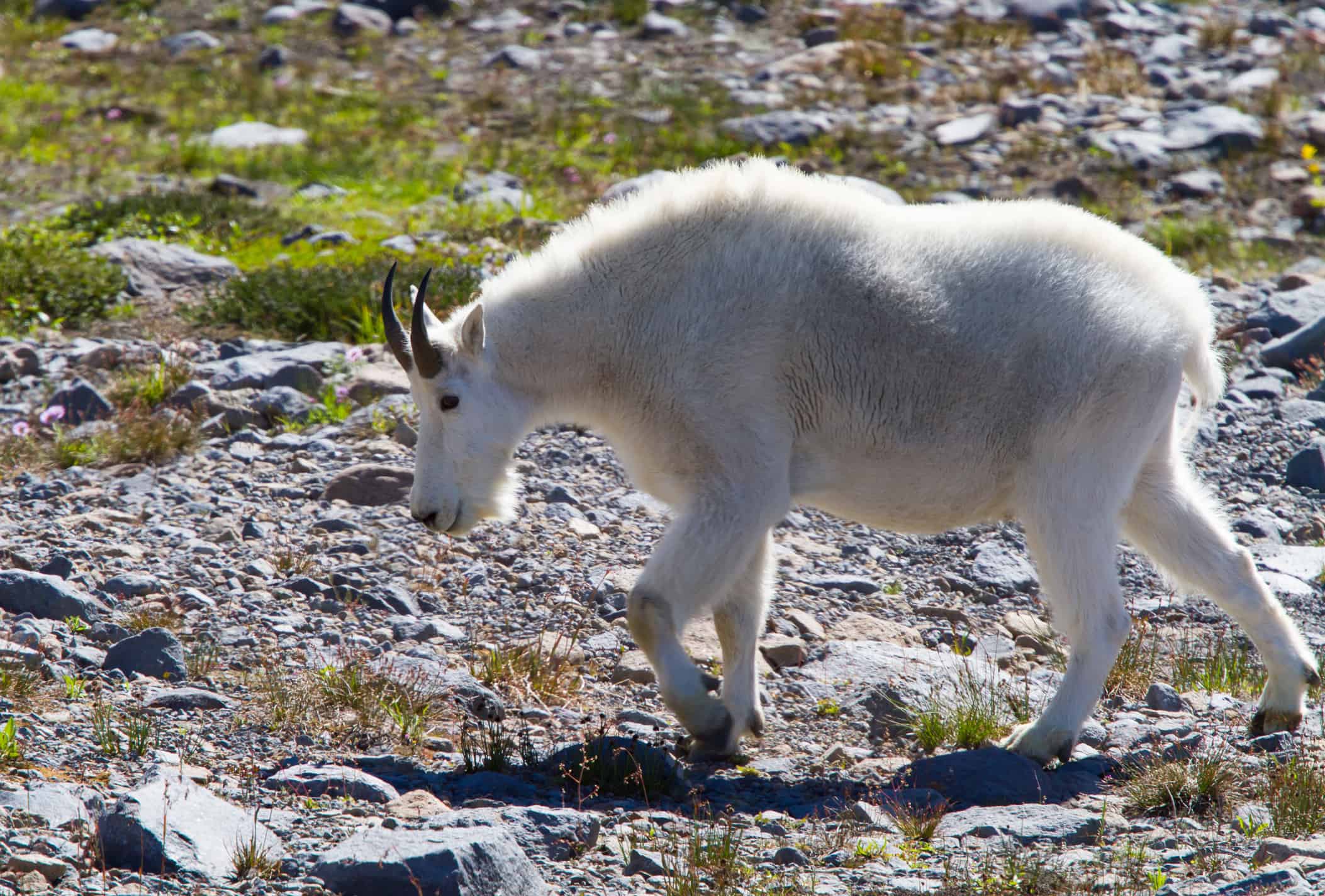
Washington State is home to 2,400-3,200 mountain goats.
©iStock.com/fremme
Black Bear
The black bear is endemic to North America and is found throughout the Okanogan-Wenatchee National Forest. It is a medium-sized bear, and although the name suggests otherwise, black bears can have many different colored coats. In fact, you can even find black bears with white, blonde, and light brown coats! Generally, adult males are larger than adult females and weigh around 260 pounds, while adult females weigh around 150 pounds.
Black bears are omnivores, and their diet depends largely on the seasons and the location. Generally, they will feed on berries, fruit, insects, fish, and even human food. Black bears like living in forested areas, so watch out for these great animals on your hike! And make sure to take some bear spray with you, just in case.
Pika
This small furry animal lives in the rocky alpine areas of the Okanogan-Wenatchee National Forest. They are closely related to rabbits and hares but are a lot smaller, weighing only 4 to 6 ounces and growing to around 6 to 8 inches long. Their dense fur ranges in color from gray to brown and provides warmth in cold alpine environments.
Pikas are herbivores and feed on a variety of alpine plants, such as grasses, sedges, and wildflowers. During the summer, they gather and store large amounts of plant material in their dens, which they use to survive during the winter when food is more scarce. Being such a tiny animal, you might have a hard time finding these little critters. However, they are a pleasant and well-worth sight for the determined photographer!
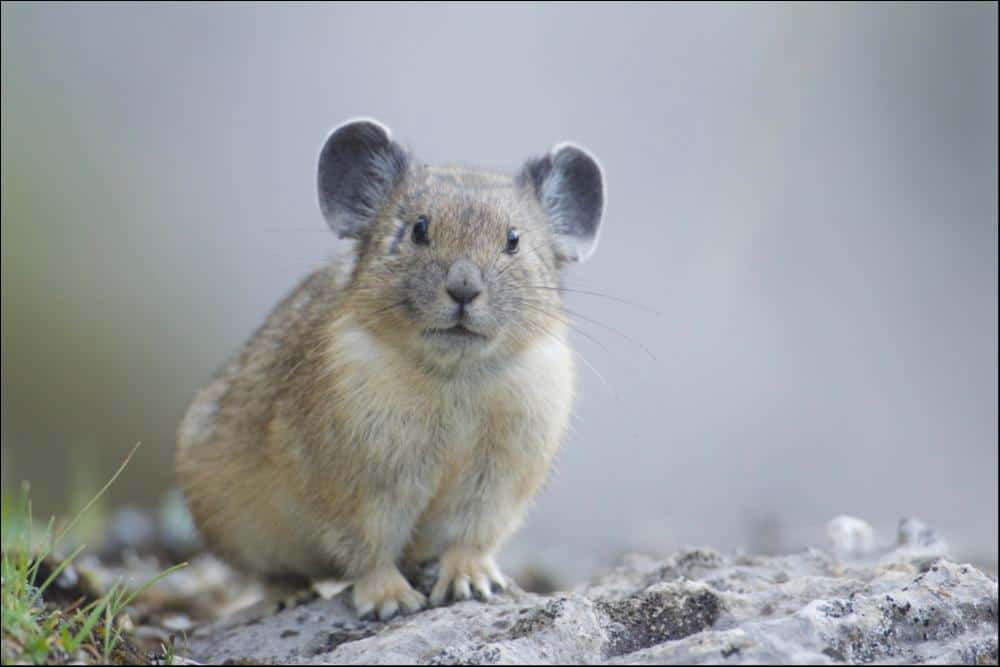
Pika only weighs 4 to 6 ounces and lives in the rocky alpine areas of the Okanogan-Wenatchee National Forest.
©Tom Reichner/Shutterstock.com
Peregrine Falcon
If you are fortunate, you may be able to spot these majestic birds on your visit to Okanogan-Wenatchee National Forest. The peregrine falcon is the fastest of all the animals in the world. In fact, these amazing birds can reach a speed of up to 242 miles per hour! This bird is generally around 13 to 23 inches long with a wingspan of 28 to 47 inches. Adult males are generally smaller than adult females; males usually weigh between 12 and 35 ounces, and adult females weigh between 25 and 53 ounces.
The peregrine falcon lives along mountain ranges, river valleys, coastlines, and even in cities. This makes the Okanogan-Wenatchee National Forest a great home for these birds! The diet of the peregrine falcon is generally medium-sized birds. They will feed on pigeons, waterfowl, songbirds, parrots, seabirds, and more.
Marmot
The marmot is a large ground squirrel that is native to the alpine and subalpine regions of the Okanogan-Wenatchee National Forest. A few different species of marmots can be found within the forest, including the yellow-bellied marmot, the hoary marmot, and the Olympic marmot. Typically, it has a short, stout body, short legs, and a short bushy tail. One of the most distinctive features of the marmot is its vocalizations. They have a deafening and piercing whistle that they use to communicate with other members of their colony. The whistle can be heard echoing throughout the valleys and mountains of the Okanogan-Wenatchee National Forest and is a very common sound to hear for visitors to the forest.
Marmots feed on grasses, sedges, wildflowers, and other alpine plants. They are primarily active during the warmer months and can be seen basking in the sun atop rocks or digging burrows in the ground. Marmots offer an important balance to the ecology of the forest, as they maintain the plant populations and provide food for predators like weasels, foxes, and birds of prey.
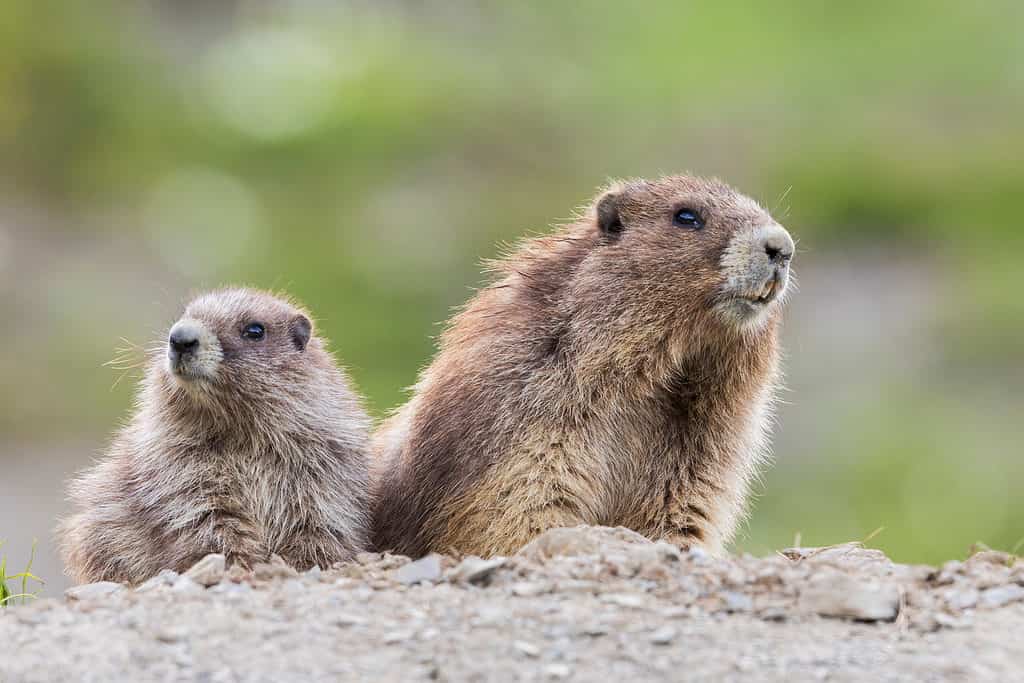
The marmot is native to the alpine and subalpine regions of the Okanogan-Wenatchee National Forest.
©Danita Delimont/Shutterstock.com
The photo featured at the top of this post is © Velimir Zeland/Shutterstock.com
Thank you for reading! Have some feedback for us? Contact the AZ Animals editorial team.






